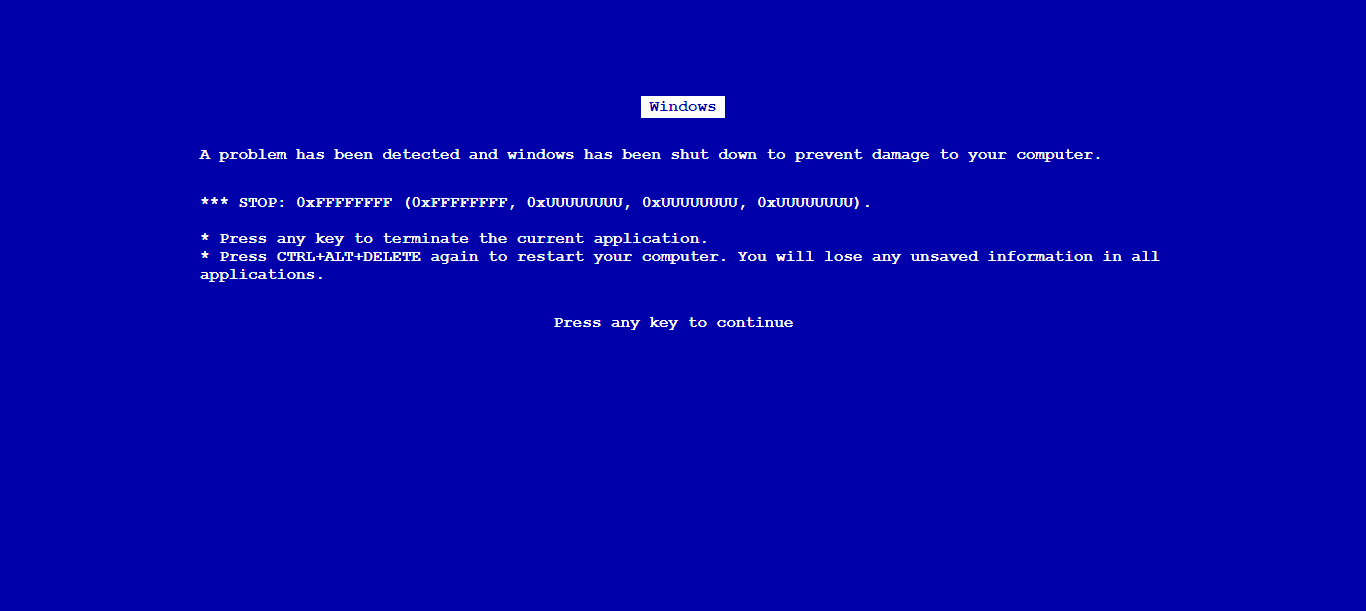Understanding The Windows Fake Blue Screen: What You Need To Know
In the realm of computer troubleshooting, few things are as alarming as a blue screen of death (BSOD). However, a new trend has emerged that raises eyebrows and concerns - the windows fake blue screen. This phenomenon can be both a prank and a tool for malicious intent, leaving users confused and anxious about the state of their system. It's essential to distinguish between a genuine error and a fabricated screen to mitigate the risks associated with it. In this article, we will delve into the intricacies of the windows fake blue screen, exploring its origins, implications, and how to safeguard yourself from falling victim to such tricks.
As technology advances, so do the methods employed by pranksters and cybercriminals alike. The windows fake blue screen serves as a stark reminder that not everything we see on our screens is legitimate. By understanding the underlying mechanics of these fake screens, users can not only enjoy a good laugh but also acknowledge the potential dangers lurking in the digital world. The aim is to empower users with knowledge, ensuring they can differentiate between a harmless joke and a serious threat.
Throughout this article, we will answer common questions surrounding the windows fake blue screen, offering insights into its creation, implications, and prevention strategies. By arming yourself with this information, you can navigate your digital environment with confidence and assurance, knowing that you're well-prepared for whatever may come your way.
What is a Windows Fake Blue Screen?
The windows fake blue screen is an imitation of the infamous blue screen of death, designed to trick users into believing that their system has encountered a critical error. This screen typically displays error messages and codes that mimic those found on an authentic BSOD, leading users to panic and fear for their data. While some versions of this fake screen are harmless pranks, others may be crafted with malicious intent, potentially leading to malware downloads or data breaches.
How Are Windows Fake Blue Screens Created?
Creating a windows fake blue screen can be surprisingly simple and often involves the use of pre-designed templates or scripts. Here are some common methods:
- Using third-party software that simulates a BSOD.
- Designing a custom HTML page that mimics the appearance of a blue screen.
- Utilizing screen capture tools to display a static image of a BSOD.
Regardless of the method employed, the goal remains the same: to evoke a sense of urgency and fear in the user, prompting them to take action.
Who Typically Uses Windows Fake Blue Screens?
While windows fake blue screens can be executed by anyone with basic technical skills, several groups are often associated with their use:
- Pranksters looking to elicit a laugh at the expense of their friends.
- Cybercriminals aiming to exploit users through social engineering tactics.
- Security researchers who use these screens to demonstrate vulnerabilities in systems.
Understanding the motivations behind these fake screens is crucial in identifying potential threats and staying safe online.
Are Windows Fake Blue Screens Dangerous?
The level of danger posed by windows fake blue screens largely depends on the intent behind their creation. In most cases, these screens are harmless pranks. However, they can become dangerous if they are part of a larger scheme to manipulate or exploit users.
What Should You Do If You Encounter a Windows Fake Blue Screen?
If you find yourself facing a windows fake blue screen, here are some steps to follow:
- Remain calm and avoid panicking.
- Do not click on any links or download any files associated with the screen.
- Close the program or browser tab displaying the fake screen.
- Run a malware scan on your system to ensure no harmful software has been installed.
- Consider changing your passwords if you suspect any data compromise.
Taking these precautions can help protect your system and personal information, allowing you to navigate digital environments more confidently.
How Can You Protect Yourself from Windows Fake Blue Screens?
Preventing yourself from falling victim to windows fake blue screens involves a combination of awareness and technical measures:
- Keep your operating system and software up to date to minimize vulnerabilities.
- Use reputable security software to detect and block malicious programs.
- Be cautious when clicking on links or downloading files from unknown sources.
- Educate yourself about common scams and tricks used by cybercriminals.
By implementing these strategies, you can significantly reduce your risk of encountering a fake blue screen or other malicious threats.
Conclusion: The Importance of Awareness in the Digital Age
As technology continues to evolve, so do the tactics employed by pranksters and cybercriminals. Understanding the windows fake blue screen phenomenon is essential for users of all skill levels. By being informed and vigilant, you can protect yourself from potential harm and navigate the digital landscape with confidence. Remember, knowledge is power, and in the case of the windows fake blue screen, it can be the difference between a harmless prank and a serious threat.
Unlocking The Magic Of Spotify Fans First Presale
Unveiling The Life And Legacy Of Laurie Holmond
Unveiling The Magic Of Lady Glitter Sparkles: The Dazzling Journey Of A Star


